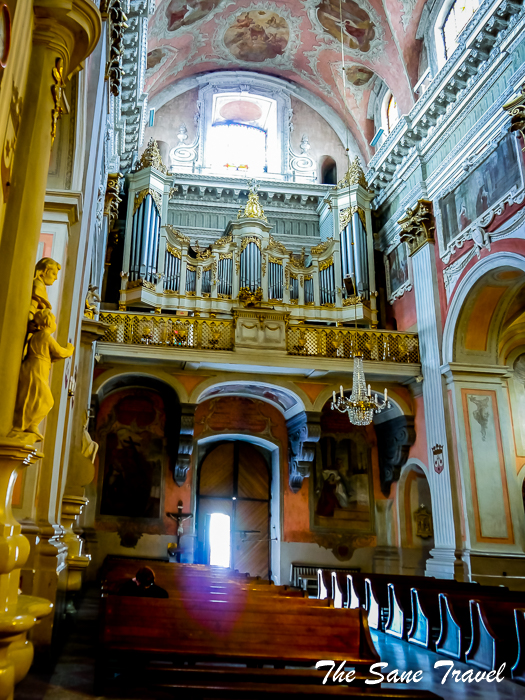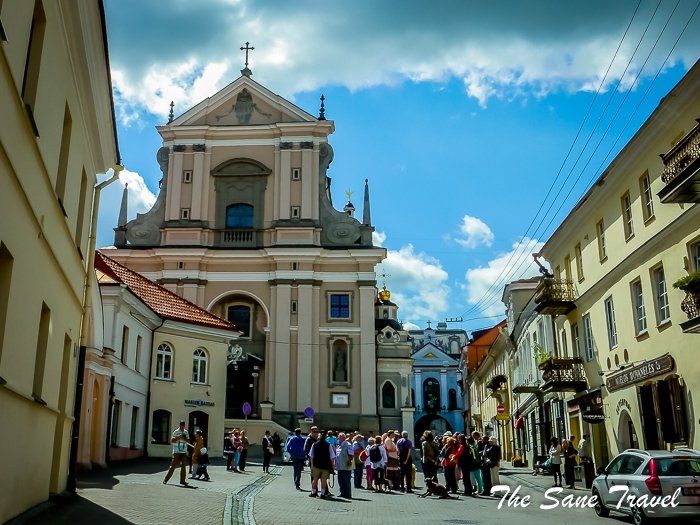In all times people paid a lot of attention and invested their best in architecture and arts meant for buildings of worship. Vilnius is a great example of that. There are many churches in the capital of Lithuania and you could easily spend an entire holiday visiting churches there. It will add great deal to your Vilnius sightseeing experience. Here is my selection of churches to visit for you to choose from. Besides those listed here the Vilnius cathedral is described in my other article. You can find it by clicking this link. So let’s have a look at the list of seven others.
1) Saint Theresa church
Built by the Discalced Carmelites in the middle of 17th century, today the Church of St Theresa of Avila is closely linked to the chapel of the Gates of Dawn. The present day interior was created in the second half of the 18th century.
Then an artist from Vilnius Motiejus Sluščianskis decorated the church's interior with frescoes that picture life and activities of St Theresa.The church of St Theresa has never been closed down. In 1844, with the closure of the monastery of the Discalced Carmelites, the church together with the chapel of the Gates of Dawn became a parish church.

2) Orthodox church of the Holy Spirit
A small gate to the right when you come from the Gate of Dawn in the direction of the Old Town leads to the Russian Orthodox church of Holy Spirit.
The complex of the Holy Spirit church and the adjacent monastery was established in 1567. The construction was ordered by King of Lithuania-Poland Wladyslaw Vasa. By the end of the 16th century, a monastery, a school and a printing shop were placed next to the church. In 1749, the church was badly damaged by fire.
After reconstruction in the middle of the 18th century, the church became the only Baroque style Orthodox sanctuary in Lithuania. The interior was crowned by a wooden iconostasis resembling a Catholic altar. Below it, a crypt was built for the relics of Orthodox saints Anthony, John and Eustatius. Today the Holy Spirit church is the main Orthodox Church in Lithuania. The male and female monasteries next to the church are the only working Orthodox monasteries in Lithuania.

Address: Ausros Vartu gatve 10
3) Holy Trinity Church of Uniates
Consisting of a church, a monastery, a belfry and a beautiful rococo gate (with the exception of the latter, much of it in a state of hideous disrepair), the Holy Trinity Church originally dates back to 1514, so it's more than 500 years old, and features elements of Gothic, Baroque and Neo-Byzantine architecture. Built at the behest of Belarusian national hero Konstantin Ostrozhsky (1460-1530), the church was extensively altered after a serious fire in the middle of the 18th century. It is the only operating Uniate church left in Lithuania and it surely saw better days.
No other faiths had their fortune depend on the political climate quite as much as the Uniates. This eastern rite Catholicism is currently centred in their church of the Holy Trinity in the Old Town of Vilnius.
The Grand Duchy of Lithuania was ruled by Catholic Lithuanian leaders but after its major expansion to modern-day Belarus and Ukraine in the 14th and 15th centuries, the majority of its population was Eastern Orthodox Slavs. The Grand Dukes of Lithuania opted to solve the problem by establishing the Uniate church in 1596. Its adherents were allowed to continue Eastern Orthodox religious practices but only those recognised by Catholic institutions.
With Lithuania annexed by the Russian Empire in 1795, the state-sponsored role of the Uniate church ended almost overnight. Its many churches and 95 monasteries were closed down or ceded to the Russian Orthodox church. The Uniate church was also among the most persecuted ones during the Soviet occupation. As a result, the Uniate Christianity is now very weak. Most of its 350 adherents are still Eastern Slavs, primarily Ukrainians.

4) Saint Casimir Jesuit church
This church, as many those of Vilnius, has a long and complex history. Founded by Jesuits and dedicated to St. Casimir, the church was finished and consecrated in 1635. It burned down in 1655, when the Russian army entered Vilnius. The church was destroyed by fire two more times, in 1707 and 1749. In 1812 the French army turned the church into a grain silo, destroying its altars, statues and paintings. In 1839 the Russians turned it into an Orthodox church known as St. Michael's. It was reconstructed at the end of the 19th century.
In 1915 the German army turned the church into a Lutheran house of worship. In 1919 the church was returned to Jesuits and restored a few years later. In 1949 the church was closed again, this time by the Soviets, who stored grain in it. At this time all the inventory of the church was destroyed, including the altars, the organ, and the bells. In 1963 the church was turned into a museum of atheism. The church was returned to the Roman Catholic community in 1988. After intense restoration the church was reconsecrated in 1991, and Jesuits work in it again.

5) Saint Anne church
St Anne's church is probably the most famous structure in Vilnius. It is a masterpiece of late Flamboyant Gothic architecture, nearly unsurpassed in the world. The brick church was constructed on orders of Grand Duke of Lithuania Alexander in 1495-1500.The church has survived into the present almost unchanged. It was renovated in 1902–1909 when the side arches were uncovered and the walls were strengthened with iron. It underwent another reconstruction in 1960–1970 when its towers were in need of restoration.
It is a surprisingly light and graceful building. It is noted for a rhythmical composition of vertical and curved lines; no solid masonry is placed above the portal, only pilasters, quadrangular poles, arches and elegant towers. Bricks of 33 kinds were used for decoration.
Many legends are associated with St. Anne's Church. The most popular story is about Napoleon. They say that upon seeing St. Anne's, Napoleon expressed his desire to place the church on the palm of his hand and carry it back to Paris.

6) Church of St Francis from Assisi (Bernardine)
This admirable building is closely connected to the St.Anne’s church. Even though the churches were built in different time periods, they have a marvellous visual bond together. The Bernardine history in Lithuania began in the middle of the 15th century, when Franciscans observants (called Bernardines) came to the Grand Duchy of Lithuania. King Kazimieras Jogailaitis donated a plot of land near the Vilnele river, where they built a church and a monastery. The two churches highlight and supplement each other. St. Anne’s Church looks a bit more complicated and intense while Church of St. Francis retains its colossal stature. Both of them are fantastic and missing out on visiting them would in my opinion be a great loss. Saint Francis church also includes a monastery and celebrates Roman Catholic mass in English every Sunday.

7) Church of All Saints
The Church was finished in 1630. It is of late Baroque style, the so-called Carmelite Baroque. A large five-tier bell tower was built next to the Church in 1743. In the same year, a two-storied building was added, with a sacristy and a library installed. While the Church was closed down between 1832 and 1886, a large part of its treasures of art was scattered. In 1904 the Church was restored. Unfortunately though, during the restoration the wall painting was badly damaged. In the Soviet times, the Church was used as a folk art museum.
In 1991 the Church was given back to Catholics and renewed, with some of its pictures returned as well. Nowadays the church is open to visitors. It is chocolate-boxy peach and white on the outside. Visitors can admire the spectacular interior with its marble finishing and an ornate central altar. All Saints is indeed gorgeous, and shouldn't be missed.

Read about 8 must see sights of Vilnius clicking this link.
Do you like visiting places of worship when travelling? What is your favourite place? Share in the comments section!
Author: Anita Sāne

About the author
Anita is a part-time traveller, passionate photographer and a retired career woman from Latvia, travelling mostly solo for more than 15 years. She is a skilled travel planner who plans and executes her travels by herself. Anita wants to show you how to travel the world and open your mind to new experiences. Follow her on Facebook, Instagram, Pinterest, Twitter and Bloglovin.




















Report
My comments